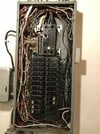What is the point of power sharing if they are on separate panels? Who told you that 60A is your max total draw? If there is a limit on the sub panel then a breaker smaller than 50A should be used.
Also, does the breaker for the J1772 in the solar panel share the same wiring back to the main panel as your solar breakers? That doesn’t sound right, like there could be some situation where that wire ampacity is overdrawn.
The subpanel is connected to the main panel which comes thru a 200A main breaker. I chose 60A as a starting point before I calculate the power to see if I can go higher.
The J1772 is in the same subpanel as the solar breaker. This calculated OK to me because the solar panels would never draw power; my wall connector is pulling 7kw and the solar panel is generating 4kw, that means the subpanel would be pulling less than if there was no solar panels, similar concept as if the solar breaker is in the main panel with other circuits.



